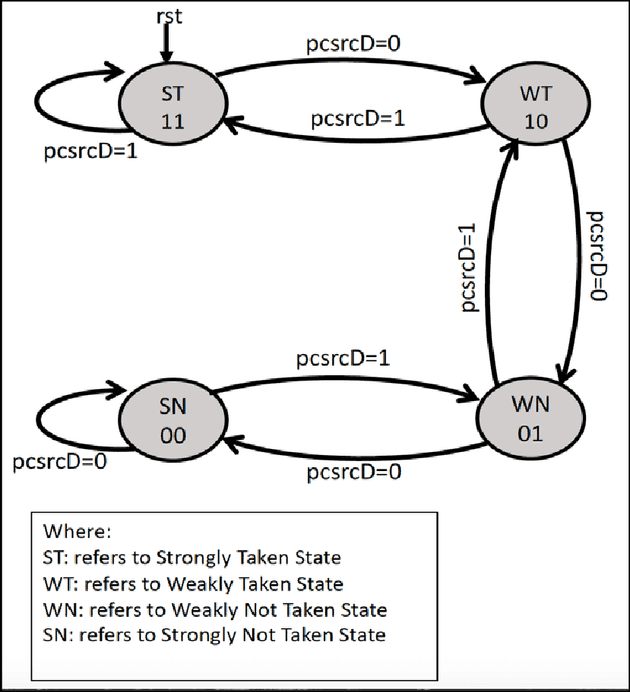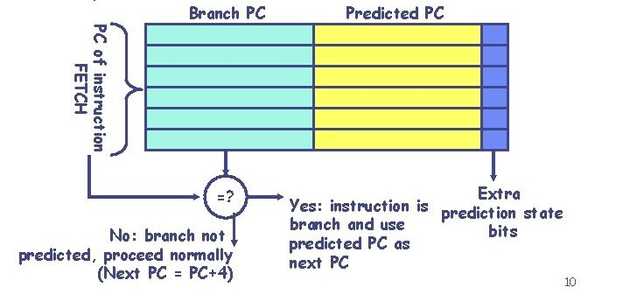In this post, we’ll take a brief look at branch prediction. To learn more about branch prediction and the hardware implementation of branch predictors, you can watch the lectures on branch prediction by Onur Mutlu (link opens a new tab), professor at ETH Zurich, previously at Carnegie Mellon - Branch Prediction I (link opens a new tab) and Branch Prediction II (link opens a new tab) from Digital Design and Computer Architecture playlist (link opens a new tab) of Spring Semester, 2020 at ETH Zürich.

Made with https://excalidraw.com/ (link opens a new tab)
Need for branch prediction
When a processor encounters a branch instruction - it has to decode the instruction to find the target of the branch. In case of a conditional branch, the direction of branch also depends on the values in the Flag Registers - you can read more about these registers in Wikipedia article titles FLAGS register (link opens a new tab). Based on the results of previous operations, these flags are set and decide the direction of current branch.

Source (link opens a new tab): https://www.quora.com/What-is-CPU-pipelining
In a modern out of order processor, decoding an instruction and predicting branch direction in case of conditional branches make take some time - a lot longer if processor is waiting for data that decides the direction of branch as a result of L1 / L2 cache miss.
In such a case, the processor predicts the outcome of the branch and speculatively starts executing down the predicted path until the branch can be resolved.
Evolution of Branch Predictors
The earliest predictors were a one bit counter. The counter value indicated the direction of previous branch - 0 for not taken and 1 for taken. The prediction for current branch would depend on previous branch and the result of current branch will update the counter for prediction regarding next branch. AS it turns out even one bit counters were fairly accurate at prediction but the high cost of flushing the pipeline in case of mis-prediction means these predictors needs to be as accurate as possible to improve performance.
The next evolution was a two bit saturated counter, where the state 00 indicated there is a strong chance branch is not taken, state 01 meant there is a good possibility branch will be not taken, state 10 meant there is a good possibility branch will be taken and state 11 meant there is a great chance branch will be taken. The diagram below shows the transition between the state based on the result of current branch:

Source (link opens a new tab): https://www.researchgate.net/figure/2-bit-saturating-counter_fig1_333641705
The transitions are as follows:
- State 00 predicts the branch will not be taken. If the branch is not taken, it stays on 00. If branch is taken despite the prediction, the state transitions to 01 getting closed to the “taken” prediction.
- State 01 predicts branch will not be taken (although with not as large a probability as state 00). If the branch is indeed not taken the state transitions to 00 indicating a bigger probability next branch might also not be taken. If the branch is taken, the state transitions to 10.
- State 10 predicts branch will be taken with moderate probability. If the branch is indeed taken the state transitions to 10 indicating a high probability next branch will be taken. If the branch is not taken despite the prediction, the state transitions to 01.
- State 11 strongly predicts for the branch to be taken. If the branch is indeed taken the state remains the same. If not the state transitions to 01 indicating weakening in probability for branch being taken.
Unlike a single bit predictor, two bit predictor depends on a larger branch history to predict next branch. Slightly better accuracy was achieved with more states and more transition. Modern processors have graduated from just predicting direction of branch to predicting the jump right from the program counter without even decoding instruction.
Branch History Table
One single counter for all the branches doesn’t give a clear picture for all branches. To address this, the single branch predictor now became a branch history table.
The table is looked up using the pc of the branch instruction to predict whether it would be taken or not. The diagram below shows a simple schematic of a branch history table.

Source (link opens a new tab): https://slidetodoc.com/lecture-9-branch-prediction-basic-idea-saturating-counter/
Note: There are several ways to design and realize a Branch History Table. Some microarchitecture implement a branch history register and that along with the prediction from the table gives the final prediction. To know more about them I highly recommend you to watch Onur Mutlu’s videos liked above on Brach Predictors.
Branch Target Buffer
Modern processors implement a lookup table known as branch target buffer in hardware that stores the program counter for the jump instruction, the program counter in case the branch is taken and a prediction counter to predict the direction of branch. If the branch is predicted to be taken, the current program counter is replaced by the program counter for the branch taken condition retrieved from the lookup table, else the program counter is incremented as normal generally pc = pc + 4 (considering 4 byte instruction size)
The image below shows the design of Branch Target Buffer in hardware:

How sensible is branch prediction?
Consider a RISC based pipeline with 5 stages and 10% of instructions are branch instructions. Consider a branch can be predicted with an accuracy of 99% (branch predictors in modern processors are in fact this accurate).
For every 1000 instructions, there are 100 branch instruction out of which 99 can be predicted correctly.
Total cycles to run 1000 instruction
= 4 + 999 (comes from the pipelined nature)
+ 2 (2 cycles wasted until the branch is resolved)
+ 5 (cycles added as a result of flush)
= 1010 cycles
Consider a pipeline that adds 2 nop (no operation) in pipeline before every branch instruction
= 4 + 999 (comes from the pipeline nature)
+ 2 * 100 (2 nop for 100 branch instruction)\
= 1203 cyclesWe can observe there is a clear performance gain with branch prediction compared to adding nops down the pipeline.
Coming up next
This is a brief introduction to branch prediction and hardware behind it. This is in no way a comprehensive look but it covers enough to give a foundation for the exploit we’ll cover later named Spectre.
This might sound repetitive by now but to get solid understanding of branch predication - from reasoning behind it, to realization in hardware - I highly recommend watching Onur Mutlu’s lectures linked at the beginning of this post. His lectures are an invaluable resource for people looking to understand computer architecture and microarchitecture implementation of these concepts in modern processors and I highly recommend watching the entire playlist to get a good understanding of braoder picture of computer architecture.
Thank you for reading till the end. I’m an undergraduate student keenly interested in Computer Architecture and I look at micro-architectural based attacks to understand more about the working of our hardware. If you find any inaccuracies in the above post, please leave a comment and I’ll address it in the next edit. Have a nice day!